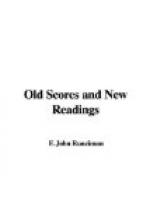Having delivered this verdict with all solemnity, I must straightway proceed to hedge. If Lamoureux had not the qualities which give Richter and Mottl their pre-eminence, he had qualities which they do not possess, and his playing had qualities which one cannot find in theirs. If he had not absolutely a genius for music, he certainly had a genius for attaining perfection in all he did, which was perhaps the next best thing. I imagine that he would have made a mouse-trap or built a cathedral exactly as he played a Beethoven symphony. The mouse would never escape from the trap; there would be nothing wanting, down to the most modern appliances and conveniences, in the cathedral. In the Fifth symphony he gave us every minute nuance in rigid obedience to the composer’s directions or evident intentions, and gave them with a fastidious care strangely in contrast with Mottl’s rough-and-ready brilliancy or Richter’s breadth. He began every crescendo on the precise note where Beethoven marked it to begin; and he gradated it with geometrical faultlessness to the exact note where Beethoven marked it to cease. In diminuendos and accelerandos and ritenutos he was just as faithful. In the softer portions his sforzandos were not irrelevant explosions, but slight extra accents: he made microscopic distinctions between piano and pianissimo; he achieved the most difficult feat of keeping his band at a level forte through long passages without a symptom of breaking out into fortissimo. His players treated the stiffest passages in the “Dutchman” overture as if they were baby’s play; and I detected hardly a wrong note either in that or in the Fifth symphony. In a word, nothing to compare with the technical perfection of his renderings, or his unswerving loyalty to the composer, has been heard in London in my time. Yet, by reason of that




